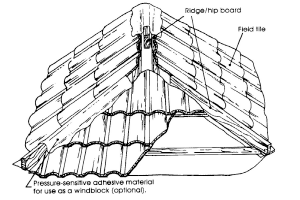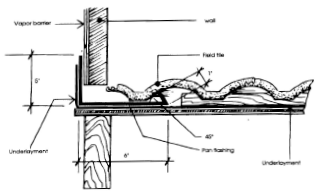Clay tiles are one of the earliest forms of steep slope roofing materials. Unlike other steep slope roofing materials, clay tiles are slow to deteriorate under the effects of the sun’s ultraviolet rays.

The main limitation on their use is a result of their weight. Flat tiles weigh approximately 46 kg/m2 (950 lb/square) and barrel tiles as much as 520 kg (1,150 lb).
The most common style is the barrel shaped although many other profiles are available. Most clay tiles are produced as single units ranging from 150 to 225 mm (6 to 9 in) in width and 300 to 380 mm (12 to 15 in) in length. A clay tile roof usually consists of two layers, with the exposure equal to less than one half the length of the tile.
Clay tile in their earliest form were all made by hand in different shapes and sizes to suit the individual potter’s tastes. And tiles were made by simply baking formed clay in the sun but are now kiln fired.
Early clay tiles were sometimes fastened with 64 mm (2 1/2 in) long dried oak pegs. Since these early tiles weighed from 73 to 88 kg/m2 (1,500 to 1,800 lb/square), fastening was not required as these tiles were held in place by their own weight.

Modern clay tiles are now made with interlocking sides and end locks to minimize the amount of overlapping that is required.
The two most common tiles are the Spanish tile and the Mission tile.
Spanish Tile
From an end view the Spanish tile resembles the letter “S”. Spanish tile is single complete tile consisting of curved tops and flat channels. Spanish tiles are secured using two nails.
Mission Tile
Mission tile looks very much the same as the Spanish tile except it comes in two half round pieces called pans and covers. Mission tiles come in tapered and barrel pattern tiles. These tiles weigh about 56.1 kg/m2 (1,150 lb/square) when installed.

